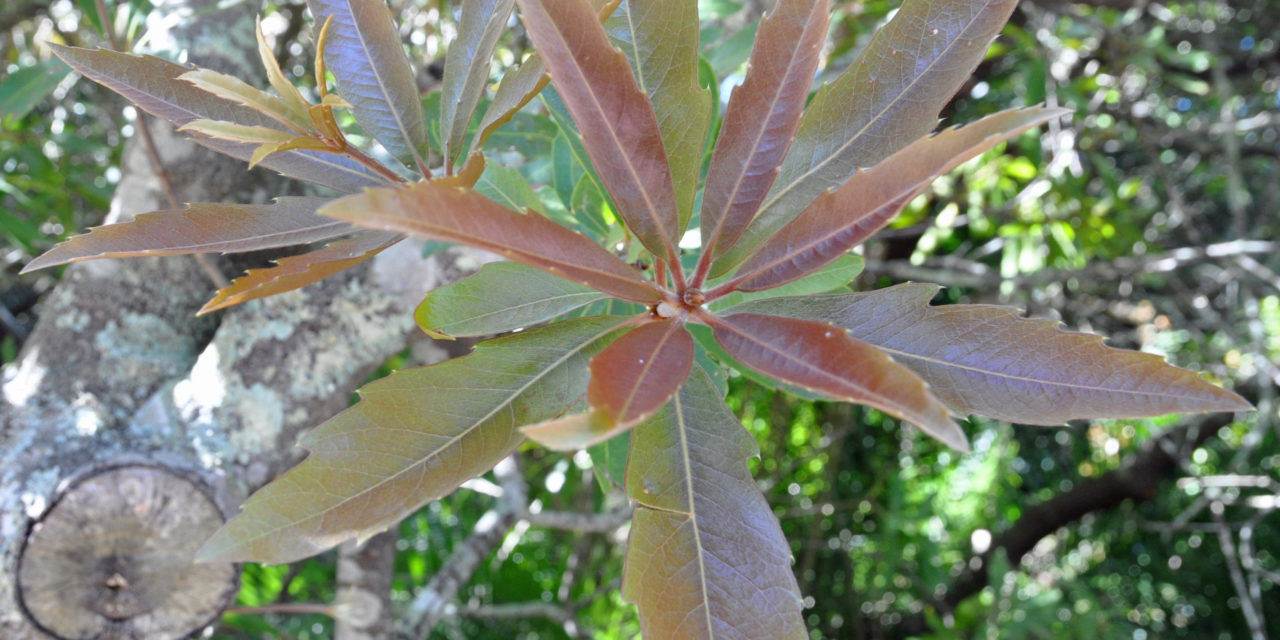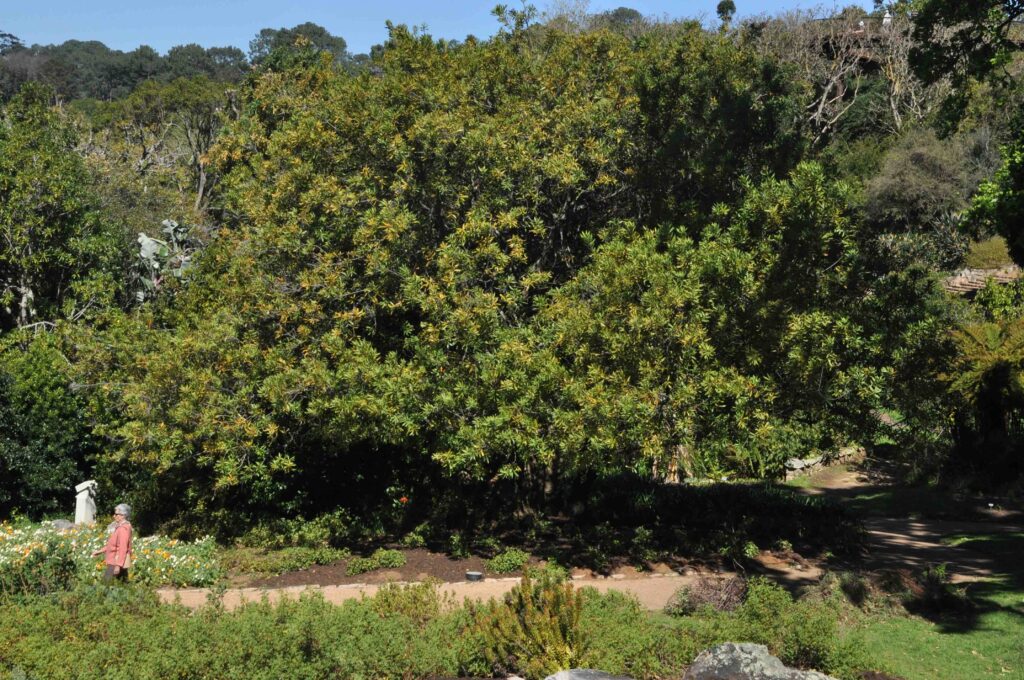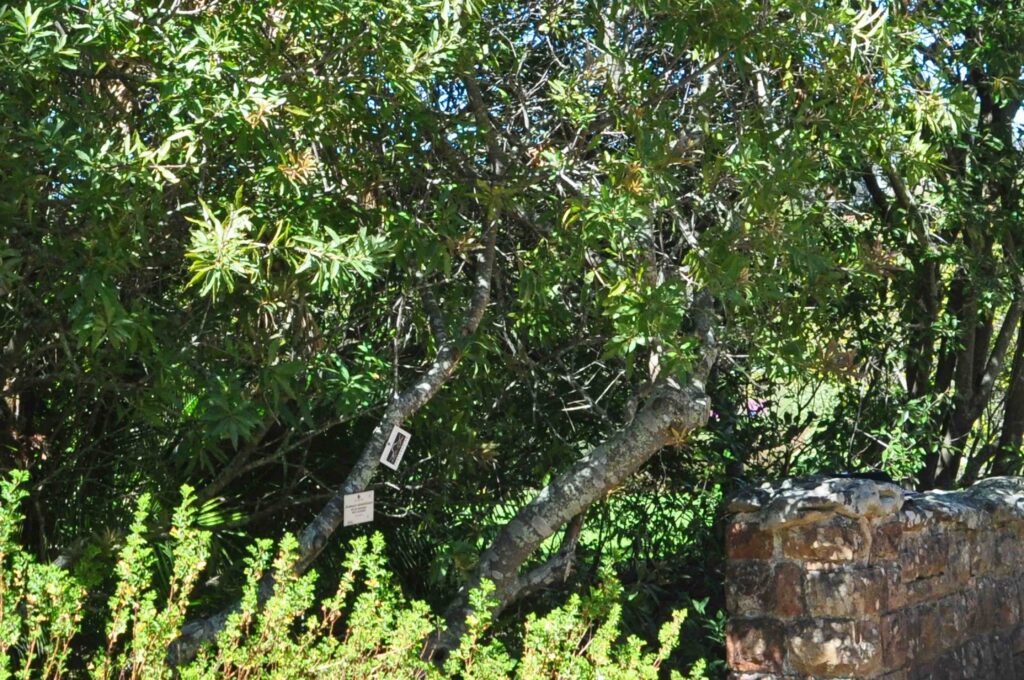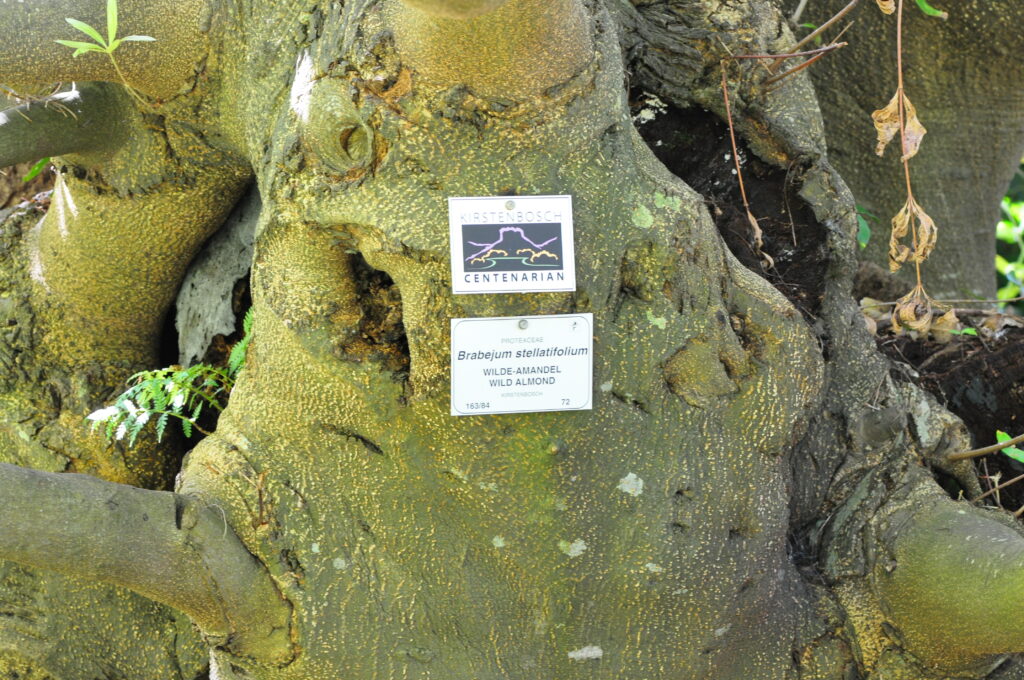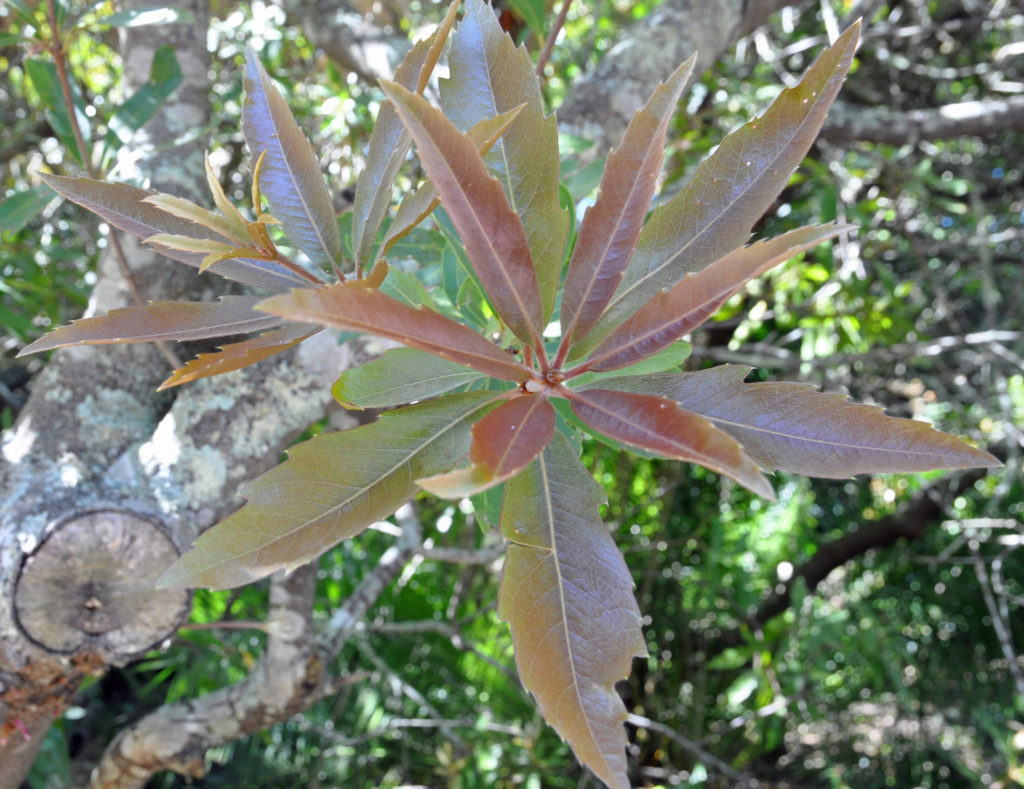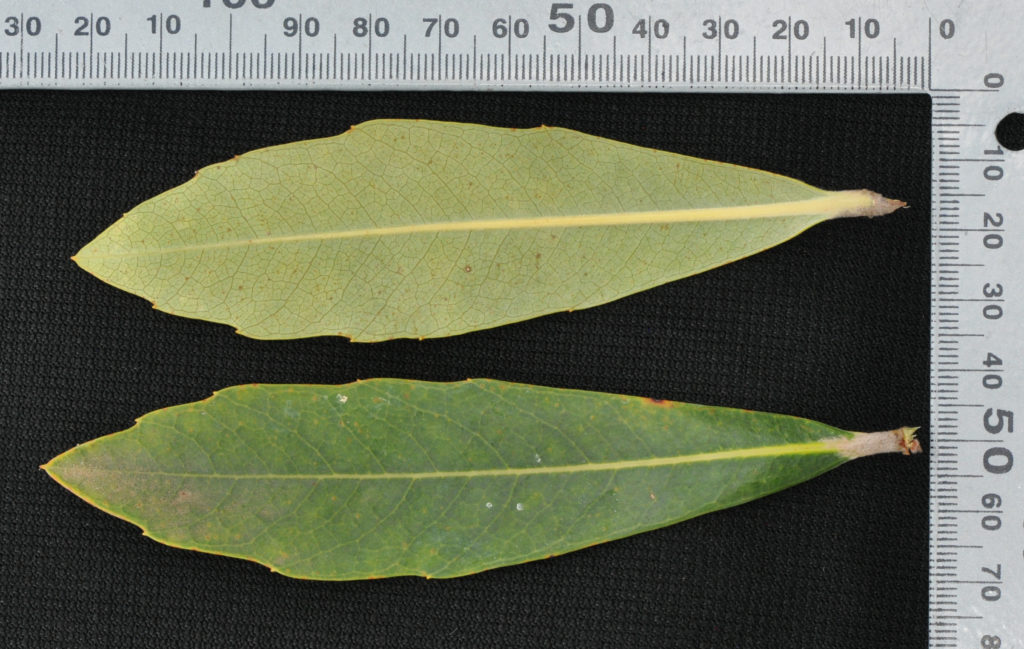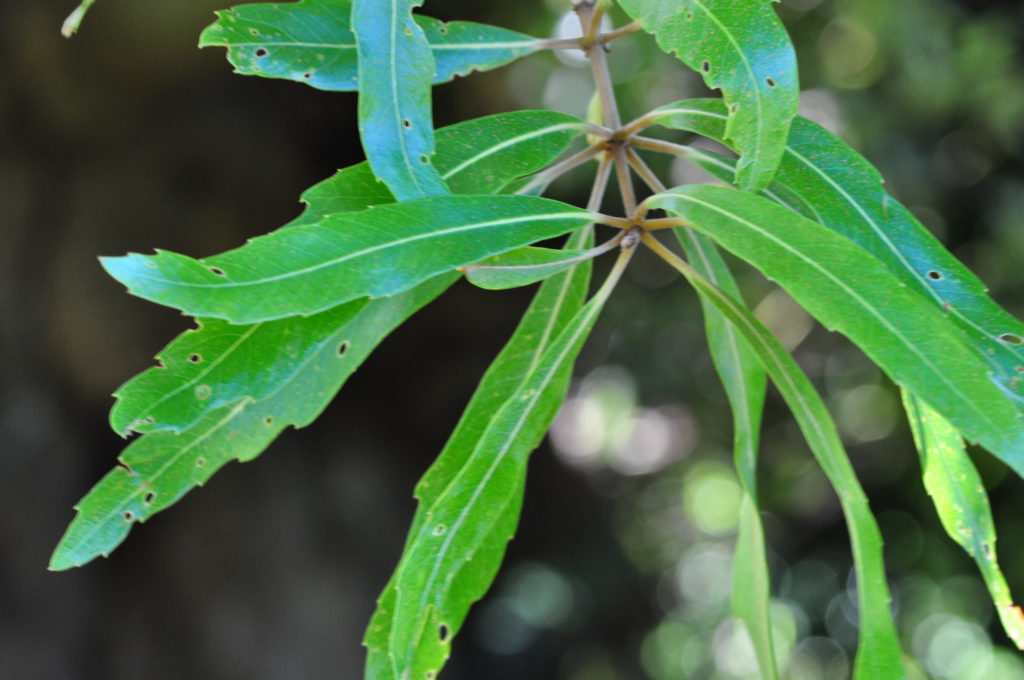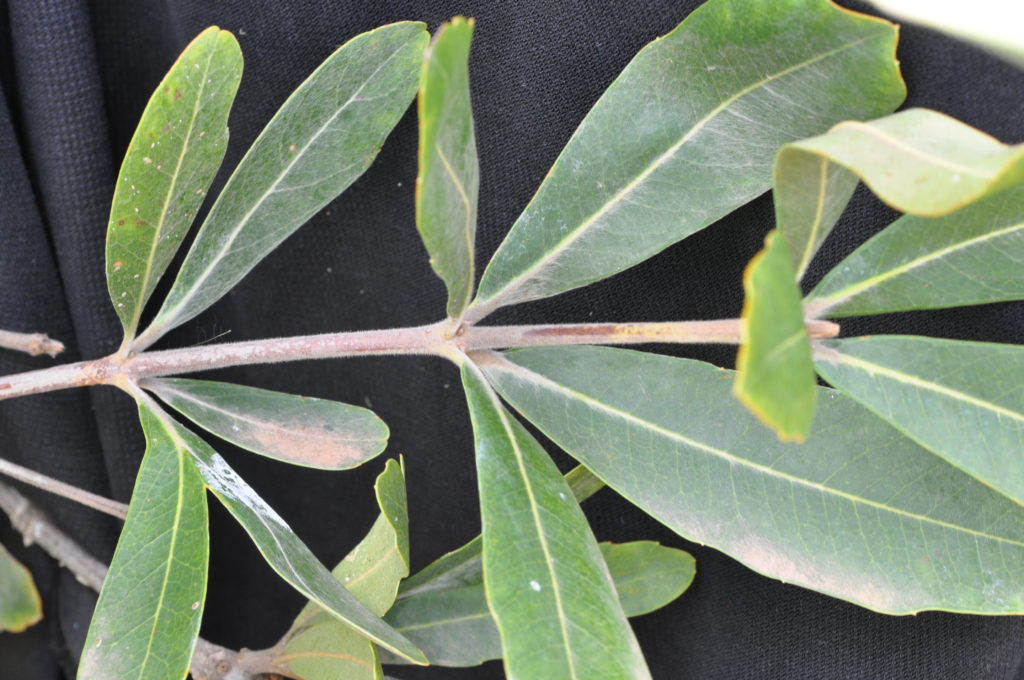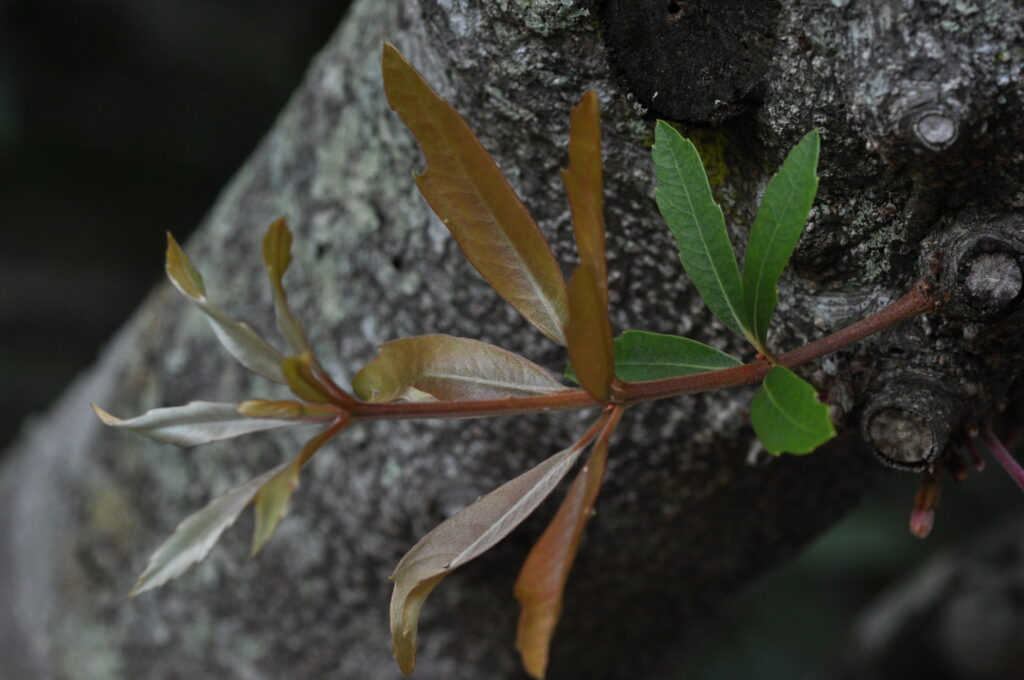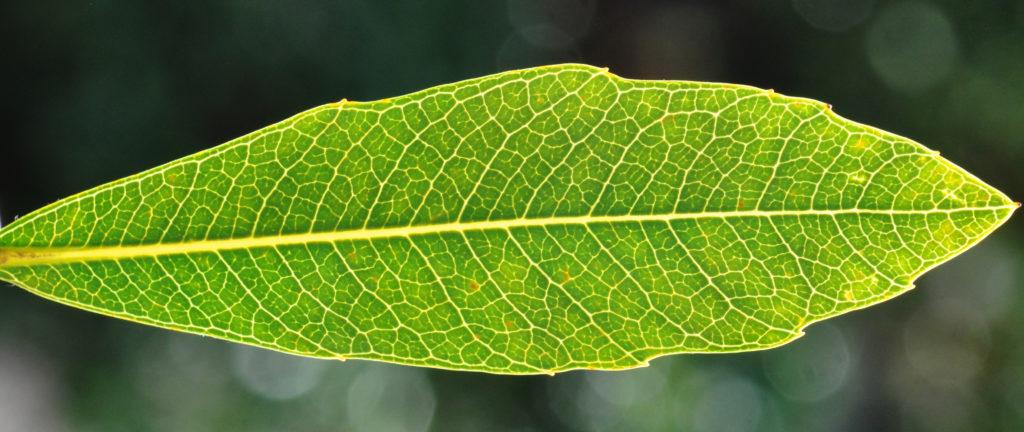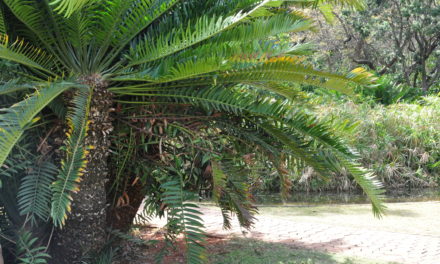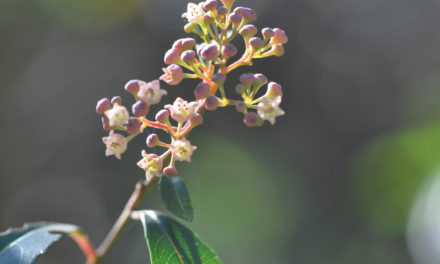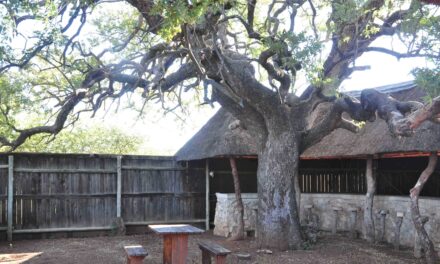Brabejum stellatifolium
General Info – summary
This evergreen Tree with thick mottled bark, spreading crown and pitted stem to 8m high. Branches may spread near the ground. The simple often lanceolate Leaves lack stipules & may be star-like, in whorls of 4 or more. Small white fragrant bisexual regular & 4-merous Flowers are in racemes. Anthers linear. Single style. Silky ovary with 2 ovules. Fruit is a velvety, low density, indehiscent drupe with 1 poisonous seed.
Description
SA Tree No. 72.
Common names: (Afr) Amandelhout, Bitteramandel, Bitteramandelboom, Bitteramandelhout, Doboontjie, Doboontjieboom, Ghoboom, Ghoboontjieboom, Ghoeboontjie (original Khoi name), Ghoekoffieboontjie, Hotnotsamandel, Hotnotsamandelboom, Wilde-amandel, Wilde-amandelboom, Wildebitteramandelboom, Wildekastaaing, Wildekastaaingboom. (Eng) African Almond, Bitter Almond, Cape Almond, Hottentots Almond, Hottentotsamandel, Wild Almond, Wild Chestnut. N.B. The True Almonds are in the family Rosaceae.
Family: Proteaceae: (Protea family). Members of this family occur mainly in the southern hemisphere. Universal characteristics are few. All are woody trees or shrubs. Anthers are basifixed and the superior Ovary is sessile. Flowers are contained in a compound inflorescence and 4 Tepals are present. There are about 80 genera and at least 1 600 species including the Australian Macadamia. (South Africa has now become one of the biggest producers of Macadamia nuts). In South Africa, there are 16 genera and 300 species. 6 genera (examples on this website) have species that are trees. These are Brabejum, Faurea, Leucadendron, Leucospermum, Mimetes and Protea. Currently the genus Protea has the most species. Protea gaguedi is the only species found in Namibia. The South African Protea flowers all have a superior Ovary containing a single ovule. The Stigma is a tiny groove resting on the top of the pollen presenter. The Style is long and thin. The silky appearance of the wood is due to the presence of medullary rays (are pith rays used for the radial conduction of water, minerals and organic substances). Leaves are Sclerophyllous (type of drought resisting vegetation adapted to prevent water loss with hard, leathery, evergreen leaves that that develop on narrowly spaced nodes). This family has similar Leaves to the Glossopteridales whose fossil leaf remains resemble the modern protea. These fossils were prevalent more than 200 million years ago. This was a time before the breakup of the super continent – Gondwanaland – due to continental drift.
Name derivation: Brabejum – Greek for septa (a partition that separates two or more chambers, called locules). This may refer to the prize at the games held in Delphi. It may also refer to the inflorescence that is a raceme. stellatifolium star-shaped – referring to the whorled, thin, long leaves which, collectively, have a star like appearance. stellatifolium is the only indigenous species in this genus. This plant is endemic (Endemism is the ecological state of a species being unique to a defined geographic location) in South Western South Africa and is closely related to the exotic Macadamia.
Conservation: National Status: L C (Least Concern. Assessed: 2019/04/11. (A.G. Rebelo, H. Mtshali and L. von Staden). Population trend is stable.
Tree
This large, often multi-stemmed shrub or medium to large Tree is up to 13m high. It has a widely spreading crown and horizontal spreading branches (photo 295). On mature specimens, the branches may be enormous and intertwined. The plant is often multi-stemmed. The Trunk is pitted. Branches start at ground level (photo 212) and continue with many erect stems. Branchlets have scattered and raised white Lenticels (a usually raised corky oval or elongated area on the plant that allows the uncontrolled interchange of gases with the environment). Rusty brown hairs cover young growth (photo 949 under Leaves). Bark (photo 205) is thick, smoothish with pale greyish-brown with stripes. It is mottled and may be twisted.
- 295. 2018/09/11. Kirstenbosch NBG. Photo: David Becking.
- 205. 2018/09/11. Kirstenbosch NBG. Photo: David Becking.
- 212. 20/13/25. Kirstenbosch. NBG. Photo: David Becking.
Leaves
This evergreen tree has irregularly toothed long Leaves (photo 204) that are lanceolate (lance-shaped – photo 204) or narrowly obovate (egg-shaped – with the narrower end at the base). They are up to 15cm long, 2,5cm wide and simple (have a single blade which may have incisions that are not deep enough to divide the leaf into leaflets – photo 355). The leaves appear in whorls of 4-9 (often 6 – photo 204), along the stem – giving a diagnostic star appearance when viewed from above (photo 204). Here a rusty golden colour may be visible on younger leaves. Mature leaves (photo 351) are dark or yellowish green, hard, leathery and up to 15 x 2,5cm. They may be finely velvety (having a smooth, soft appearance – photo 949) or hairless but do have conspicuous net veining. These veins are clearer on the lower surface or especially when viewed against a strong light (photo 361). Here a hand lens will help. The Margin is irregular and may be coarsely or sharply serrated (photo 213). Each serration has a side vein feeding into it (photo 361). The Petiole (leaf stalk – photo 355) is up to 1,5cm long. Leaves in this photo have a distinct Midrib visible on both sides. The Apex and Base both taper. Domatia may be present (Domatia are tiny chambers produced by plants that house arthropods). To the naked eye, the domatia appear as small bumps. They are intended to be used by organisms that have a symbiotic relationship with the plant and develop in axils of principal side veins. Stipules (basal appendages of the petiole) are absent.
- 204. 2018/09/11. Kirstenbosch NBG. Photo: David Becking.
- 355. 2016/01/26. Pretoria NBG. Photo: David Becking.
- 213. 2013/03/25. Kirstenbosch NBG. Photo: David Becking.
- 351. 2016/01/26. Pretoria NBG. Photo: David Becking.
- 949. 2018/09/15. Kirstenbosch NBG. Photo: David Becking.
- 361. 2016/01/26. Pretoria NBG. Photo: David Becking.
Flowers
The usually numerous, bisexual (occasionally unisexual by abortion), small and sweet-scented white Flowers are up to 5mm long. They occur in spike-like Racemes (a simple, unbranched, indeterminate inflorescence with stalked flowers along the axis that open in succession towards the apex). Each raceme is up to 8cm long and occurs in leaf axils near branch ends. Two glabrous (hairless) Flowers are present in the axil of a bract (modified specialised leaf usually found with inflorescences and flowers). Here the bracts are velvety (having a smooth, soft appearance) and fall when the flower opens. There are 4 parts to the Perianth (the 2 floral envelopes considered together; a collective term for the Calyx and Corolla), which separate to the base when the flower opens. Four Stamens are slightly shorter than the perianth segments and their linear Filaments are not attached to the perianth. The oval Anthers have a dark rounded apical boss (protuberance or roundish outgrowth). There is a single Pistil (a unit of the Gynoecium, the female element of the flower, composed of the Ovary, Style and Stigma) and the silky superior Ovary contains 2 pendulous ovules and rests on a circular disc (a more or less fleshy or elevated development of the receptacle). The single straight Style has an acute apex. (Dec-Jan).
Fruit
The almond shaped (oval or ellipse) Fruit is a woody, indehiscent Drupe (a fleshy, single seeded indehiscent fruit with the seed enclosed in a stony endocarp – the innermost layer surrounding the seed; stone fruit like a peach) that is up to 4,5 x 3cm. The hairy young fruit is magenta coloured (midway between red and blue). Rusty/chocolate brown hairs cover the ripe Fruit. The fruit occurs at branch ends and closely resembles the cultivated almonds fruit – hence the common name. Fruits have a low density, are less dense than water and releases the brown seeds directly after ripening. The presence of cyanogenic (containing toxic hydrogen cyanide) glycosides providing a bitter taste. (Feb-May).
Distribution & Ecology
Wood-boring insects and porcupines eat the Nuts. In spite of it containing cyanide, Grey Squirrels and Cape porcupines consume the Fruit. The tree is visible on the Wynberg hill at Kirstenbosch, where it was originally used to make Van Riebeeck’s Hedge. It also occurs on the east side of Table Mountain. Seeds are water dispersed. The plant grows along streams, (including streams that pass-through Kirstenbosch) in sheltered valleys, in forests – usually near the coast and Fynbos (from fijnbosch meaning fine leafed bush). All these plants occur below an altitude of 1 200m. The Cape Floral Kingdom is the smallest of the six Floral Kingdoms in the world and is the only one completely contained in a single country – South Africa. This area is characterized by its high richness in plant species. There are about 7 000 species contained within 46 000 km² and its high percentage of endemic species (68%) are confined to the Cape Floral Kingdom. Metrosideros angustifolia and Rhus angustifolia are trees that often occurs with Brabejum stellatifolium and all can recover after fire damage by resprouting from underground. Insects are the Pollinating agents, and these attracted insects themselves attract birds. However, honey made from these plants is reported to leave a bitter aftertaste.
Ethnobotany
Raw Fruit, which resemble almonds, contains cyanide and are poisonous when eaten raw. If the fruit is soaked in water, boiled and roasted it can apparently be eaten or used as coffee. The Wood is reddish brown and has been used for ornamental work. The Bark is useable for tanning. This is not a plant for a small garden. Trees grow from fresh seeds in an initially moist environment. In 1661, Brabejum stellatifolium became the first indigenous tree to be planted by settlers in South Africa making excellent hedges. Today the 300+ years old “Van Riebeecks’s Hedge” (Brabejum stellatifolium) is visible at Kirstenbosch National Botanical Gardens.
References
Coates Palgrave, M. 2002. Keith Coates Palgrave Trees of Southern Africa, edn 3. Struik, Cape Town.
Lawrence, G. H. M, 1951. Taxonomy of Vascular Plants. The Macmillan Company, New York. Tenth Printing 1965.
Palmer, E. & Pitman, N. 1972. Trees of southern Africa. Balkema, Amsterdam, Cape Town.
Rebelo, A.G., Mtshali, H. & von Staden, L. 2019. Brabejum stellatifolium L. National Assessment: Red List of South African Plants version . Accessed on 2025/02/20.
van Wyk, B. & van Wyk, P. 1997 Field guide to Trees of Southern Africa. Struik, Cape Town.
http://www.plantzafrica.com/vegetation/fynbos.htm
http://www.plantzafrica.com/plantab/brabejstell.htm
http://www.biodiversityexplorer.org/plants/proteaceae/brabejum_stellatifolium.htm
https://en.wikipedia.org/wiki/Brabejum
http://www.sanbi.org/gardens/kirstenbosch/virtualtour/kirstenbosch-nbg-van-riebeecks-hedge
http://www.fynboshub.co.za/fynbos-conservation/what-is-fynbos/

